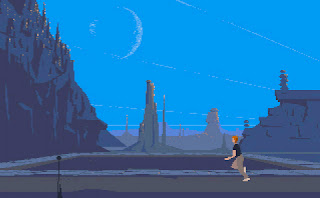There’s a tabletop game that I played in college called Unknown Armies. You might know of it. It’s a game about fantasy and horror that occurs under our noses in the real world.
Unknown Armies has, in its setting materials, the concept of Ascension. If someone in the world really internalizes, and symbolizes, a particular archetypal type of person, they might Ascend as the Platonic ideal of that archetype. That person doesn’t actually die; they just disappear and become an incarnation. If people claim, for example, Elvis isn’t dead, maybe he isn’t. Maybe he just Ascended to the Unknown Armies pantheon as The Rock Star. One example used in the book is Amelia Earhart, who Ascended as a symbol of freedom called The Flying Woman. And so-on.
Last year I was lucky enough to be in the audience for Eric Chahi’s post-mortem of Another World at GDC. Slides are here. We were there to listen to Chahi’s stories about the process of creating this classic game.
I played the game myself when it was called “Out of This World” on the Sega Genesis. The introduction music – which Chahi insisted, adamantly, must be kept the same as the original game – was even taped to a home-made “best game soundtracks” tape that I listened to many, many times over the course of my life.
When I was in the audience, listening to Chahi talk about the game, I had this weird, random thought enter my brain. This man, I thought, is The Artist.
Not “an artist.” That would’ve been perfectly valid of course, but that isn’t where my brain went. I thought: The Artist.
Sure, the French accent didn’t hurt. When you think about the archetypal artist he probably has a French or some other type of European accent.
And I am not saying that I wish on Chahi some kind of mysterious Ascension-related death.
What I really mean, though, is that everything he talked about in the process of creating this game is what we think about when we think about creating a work of art.
Another World was breaking ground in creative tool use, making beautiful pictures and animations from painstaking detail-oriented mathematics. Otherworldly beauty was literally created from a void. The game narrative also progressed in its meaning as time went on, in an unusually linear fashion since it was worked on more or less chronologically. The process of creating the game, Chahi said, mirrored his emotions and how he was interacting with the world at that time. What originally had an uncertain meaning developed one during the creative process: a story about fear, then friendship, about captivity, and then escape.
Chahi sometimes had to fight with others to realize his vision, people who questioned his decisions. Sometimes he won, such as with the music. But he also had to roll with just a little (almost comedic) censorship.
The game’s ending, flying off into the sky, the future uncertain, contained more personal meaning. By the end of the process, Chahi claimed he was exhausted, and so, the character Lester was also exhausted. Flying off indicated the end of the process and a new kind of freedom.
It was really a very moving speech. It’s hard to get the feeling of all that just from looking at the Gamasutra writeup, so (this one time only) you should probably read the comments too.
This is to say nothing of the other games that have been selected for the MoMA collection. Pac-Man, Tetris, excellent choices. I may have my grievances with Passage, but I do not deny its essential artiness. Dwarf Fortress is of course an absolute masterwork.
But as someone who heard the post-mortem, I really want to thank the Museum of Modern Art for putting Another World where it belongs. It’s finally home.

Leave a Reply